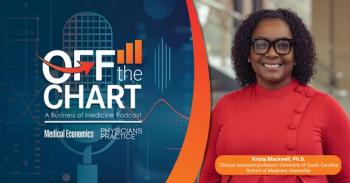
Primary care physicians play key role in diagnosis and management of age-related macular degeneration
There is no cure, but early detection and treatment may preserve visual health.
Primary care physicians (PCPs) are in a unique position to identify early signs of age-related macular degeneration (AMD) in individuals at risk of vision loss. Although there is currently
AMD is
Patients with AMD can have
- Dry (atrophic) AMD (dAMD) accounts for 80% of reported cases and is characterized by a slow degeneration of the retinal pigment epithelium and retinal photoreceptors.Dry AMD can either progress to geographic AMD (late-stage dry AMD) or wet AMD, both of which are considered end-stage disease.
- Wet (neovascular) AMD accounts for only 20% of cases but has a more aggressive course, with rapid deterioration of vision. Wet AMD is responsible for up to 90% of cases of legal blindness caused by AMD.
Risk factors associated with AMD include increasing age, cigarette smoking and race. Older age is the most significant risk factor with the prevalence of AMD increasing with age.
PCPs provide critical patient support
PCPs can be the first to recognize symptoms and the need for referral to ophthalmology in this population. Early recognition and coordinated care between PCPs and vision specialists will lead to timely management, which may decrease the incidence of permanent blindness due to AMD.
Education: All at-risk patients should be educated about healthy lifestyle choices: regular exercise, smoking cessation, wearing protective eyewear in the sun and including fruits, vegetables, fish and nuts in their diet.
Psychosocial needs: Because depression and anxiety may develop as a result of vision loss, patients may benefit greatly from antidepressant medication, psychological counseling or referral to a support group. Once a patient's visual acuity has reached the point in which self-care becomes difficult,
Monitor vision changes: While no approved treatment exists for early AMD, patients may be given an Amsler grid to self-evaluate on a regular basis for any changes in vision, such as missing areas of the grid or distorted/wavy lines.
The Amsler grid is a simple square containing a grid pattern and a dot in the middle. When used correctly – weekly or as often as daily – the Amsler grid can show problem spots in your field of vision.
PCPs can also ask patients to test their vision in each eye by regularly covering one eye at a time and reading, noting any new changes in vision. Follow-up should be arranged anywhere from six to 24 months, with the understanding that patients should return promptly if they experience any new symptoms.
Nutritional supplements:
Vital research underway
All stakeholders in vision care applaud the breakthrough research that is bringing hope to millions of patients facing the challenges of dry AMD.
Ocugen Inc., a biotechnology company focused on discovering, developing, and commercializing novel gene and cell therapies and vaccines, announced on March 13, 2024, that dosing is complete in the first cohort of its Phase 1/2 ArMaDa clinical trial for OCU410 (AAV-hRORA) – a modifier gene therapy candidate being developed for geographic atrophy (GA), an advanced stage of dry Age-Related Macular Degeneration (dAMD).
In a recent announcement, Matthew Levine, director of grants, advocacy and partnerships at AMDF, said, “The continued advancement of OCU410 offers hope to those whose vision is already deteriorating that their remaining vision could be preserved and could potentially prevent others with an early dAMD diagnosis from developing any significant vision loss.”
Approximately 10 million Americans and more than 266 million people worldwide are dealing with dAMD. It is characterized by the thinning of the macula, the part of the retina responsible for clear vision in one’s direct line of sight. Patients with dAMD experience the slow deterioration of the retina with submacular drusen (small white or yellow dots on the retina), atrophy, loss of macular function and central vision impairment. In total, dAMD accounts for 85% to 90% of the total AMD population. Such statistics underscore the urgency for continued research and innovative treatments to mitigate the burden of dAMD on global eye health.
Shawn Murphy is board vice president of the
Newsletter
Stay informed and empowered with Medical Economics enewsletter, delivering expert insights, financial strategies, practice management tips and technology trends — tailored for today’s physicians.
















